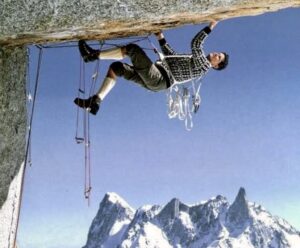When your playground is ice, and your sport involves climbing it alone, even small accidents can render the climber merciless, regardless of skill.
Ice climbing legend Guy Lacelle was sadly a casualty of his sport, through which he inspired climbers around the world.

Guy Lacelle at play on vertical ice.
On December 10, 2009, Lacelle was at the Bozeman Ice Festival in Montana, participating in the Ice Break competition. Here, a local climber paired with a non-local to climb as many routes in a particular canyon as possible, in a single day. In the inaugural 2007 Ice Breaker competition, Lacelle and partner Ross Lynn won the men’s title, climbing 13 pitches in nine hours.
This time, Lacelle was paired with local guide Adam Knoff. While in a gully between climbs, a party above triggered an avalanche. When snow fell on Lacelle below, he was pulled from the cliff and fell 300m to his death. Knoff was not hurt in the avalanche.
Lacelle was 54 at the time of his death and is thought to have completed more ice climbs than any other person. He meticulously documented each climb in a diary of sorts, which his widow, Marge Lachecki, now has.
“Guy loved chronicling things and he had a record of every single climb he’d ever done. If he did it 100 times, it was going to be chronicled 100 times,” Lachecki says.
Born in Hawkesbury, Ontario, and living in British Columbia at the time of his death, Lacelle is particularly famous for extraordinarily difficult solo ascents. Some of his most notable include: the first solo link of the Terminator/Sea of Vapors and the Replicant in five hours; Weeping Pillar and Polar Circus in a day; French Maid, Curtain Call and La Pomme D’or in Quebec; Au-delà des Ombres in France; and Hydnefossen in Norway. He won the Festiglace Competition in Quebec in 2004, and the ice competition in Ouray in 2000 and 2001.

Guy Lacelle spent more than six months a year on ice, and one of his favorite regions was Norway, particularly the routes on Hydnefossen.
His first ascent was the 100m La Congelée outside Quebec City, which he and his partner did at the time in seven hours. He later did the climb solo in less than five minutes.
Lacelle’s legacy is centred around his impressive technical ability. But despite his excellence, he was personally unassuming and down to earth, a man who found richness in connections with people and nature.
“He was a happy man and he tried to spread his happiness wherever he went,” said Lachecki. “Some people said he was an original, others said he was crazy. People thought he died poor because he had no money, but he felt rich because he had many friends all over the world.”

Guy Lacelle was rich in the friendships he made all over the world.
In a rare glimpse of how Lacelle viewed the uncertainty of ice, Alpinist magazine once asked him, “Do you accept death as an outcome of free solo climbing?”
He replied: “I would say that death is a possible outcome of free soloing, but so is rope climbing and driving a car. For me, death means losing the game, and I hate losing. I don’t live as close to the edge as I used to do. I am a little more comfortable with keeping a better margin of safety then I used to, but I still feel most alive when soloing serious climbs.”
In the “delicate dance between effort and precision” that is ice climbing, Lacelle was a master.






